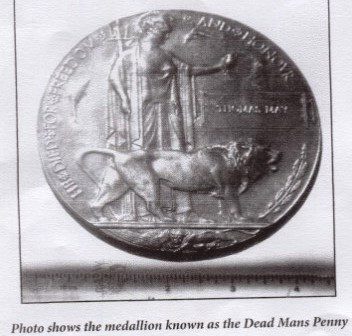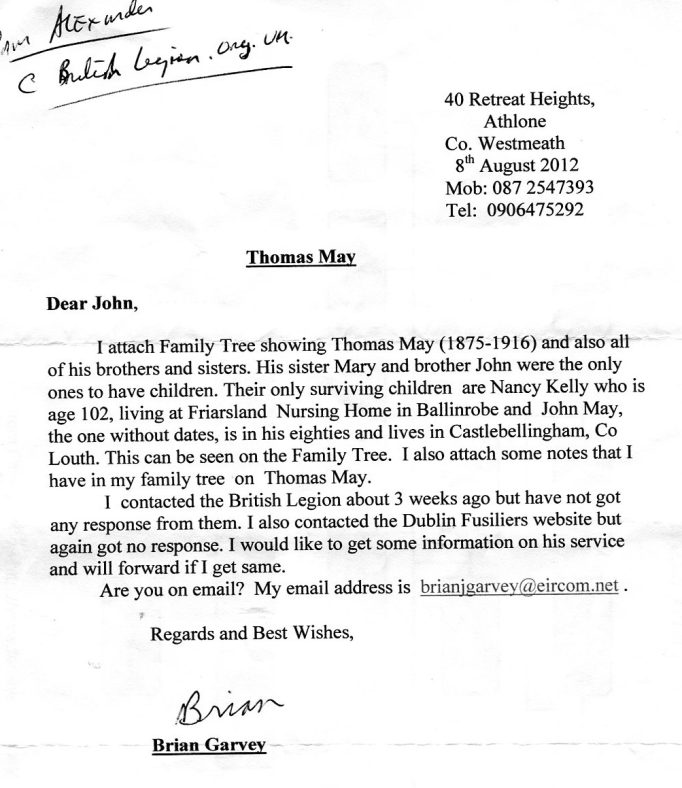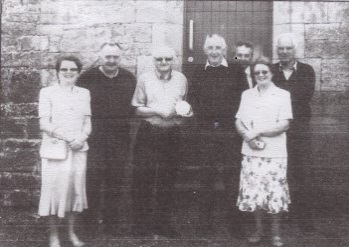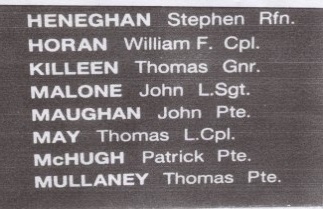During the demolition of the old workhouse in Ballinrobe some years ago I came across the medallion shown in the attached photograph. It is known as the Dead Man’s Penny and one was presented to the relatives of soldiers who fought in the Commonwealth armies and were killed in the 1st World War 1914-1918.
The medallion measures 121mm (4.75inches) in diameter and weighs 333 grams or 3/4 lb approximately and is made of bronze gunmetal. No rank was put on the medal with the name, as it was felt that each casualty had made an equal sacrifice, whether officer or private soldier.
Around the edge of the medal is engraved “He died for Freedom and Honour” and the name of the deceased is in a panel on the right hand side, with Britannia and a lion occupying most of the medal’s face.
The one in my possession was presented to the relatives of one Thomas May and so far I have not been able to establish any facts about him. There is a reference to a Thomas May from an Irish regiment who is buried in Cork and is mentioned on the website of the Commonwealth War Graves Commission, but I have not found any reason for the medallion to have been found in Ballinrobe Workhouse. I would appreciate any information about Thomas May that anyone may have, and I would try to ensure that the medallion was returned to the appropriate family.
I finished the previous article by stating that I would like to present the medallion to any surviving relatives of the man named on it, in this case Thomas May. Having made some enquiries and surfing the website of The War Graves Commission, I discovered that he was a volunteer in the Dublin Fusiliers.
Ivor Hamrock, librarian with Mayo County Council at Castlebar showed me a copy of Mayo Comrades of The Great War’ and there is an entry from Thomas May on page 114 of that book. This gives details of his enlistment, death and burial location.
He was born in Ballinrobe; he enlisted in Ballinrobe and was a Lance-corporal in the 3rd Battalion, Royal Dublin Fusiliers. He died in the Military Hospital in Cork on October 10th 1916. Through the good offices of Mr Gerard Delaney, South Mayo Family Research Centre in Ballinrobe I obtained a copy of Thomas May’s death certificate. This shows the cause of death was Tubercular Peritonitis and exhaustion after six weeks in hospital. He was 34 years of age at that time.
His grave is located in the Cork Military Cemetery, Cork, with memorial headstones 300 and 48. He is commemorated on a special monument there. A search of the 1901 census records from Ballinrobe shows a Thomas May in Knockferren, age 25 and school master of the Workhouse. This could explain why the medallion was found in the Workhouse, as he enlisted in Ballinrobe and it would have been his address. According to the census he was not married at the time. There seems to have been a slight confusion regarding his age when he died, but I understand that such errors were not unusual in the circumstances at that time in the war years.
Local enquiries indicate that he was from a family of teachers, and with Gerard Delaney using his records we are nearly 100% sure that we have identified his surviving relatives. We now must find his closest next of kin; I will then return the medallion to them, 95 years after his death. I hope this can be done with the appropriate ceremony, and if that happens I will have a full report, with photos for the next issue of Cunga 2012.
Further research produced more information for the 2012 issue
As I discovered, Thomas May was a lance corporal in the 3rd Battalion Royal Dublin Fusiliers.
He was born in Robeen and was christened on April 11th 1875 in Robeen church. Prior to enlisting in the army he worked as a schoolmaster in the workhouse in Killosheen in Ballinrobe. He was one of five children, his father and mother were Martin May and Mary Anderson, and he himself never married. His sister Mary and brother Jim had children, and their surviving children are Nancy Kelly who is 102 years old and lives in Friarsland Nursing Home in Ballinrobe, and John May who is in his eighties and lives in Castlebellingham, Co. Louth.
In the course of searching for information on Thomas May, I contacted Gerard Delaney of the South My Family Research Centre in Ballinrobe. He told me of Mr Brian Garvey of Athlone, who was carrying out research on his family tree, and it transpired that Mr Garvey was related to Thomas May.
With the assistance of Mr Pat Caulfield of Carnalecka, Ballinrobe, I contacted Brian, and he sent me very detailed information about the May family, complete with the family tree since 1805. Brian is in fact the grandnephew of Thomas. After some discussion with Brian Garvey we decided that it would be appropriate to present him with the medallion at the workhouse location where I found it.
This was done on September 4th 2012 and we photographed the handing over. Those attending the ceremony were: Mr Brian Garvey, Mrs Peggy Garvey, Mrs Alice Heneghan from Shrule, Thomas Mays grandniece, Pat Caulfield, Gerard Delaney and Matt Masterson, both from the South Mayo Family Research centre and myself. I must thank all who helped me in the search for information on Thomas May. Pat Caulfield and Gerard Delaney were of great assistance, as was Ivor Hamrock, librarian at Castlebar.
Note: These articles appeared in three parts in the years 2010, 2011 and 2012 in the Cunga magazine; information was added as research was ongoing. Editor Averil Staunton








Comments about this page
Many thanks Averil.
Congratulations are due to John Fergusion for his efforts to locate the family of Thomas May plus return their Medallion from the Workhouse. It has a lovely description of Thomas May’s life … so fitting he is now remembered on this site.
Editor: Many thanks Noelene, great work you are doing. Averil
Add a comment about this page